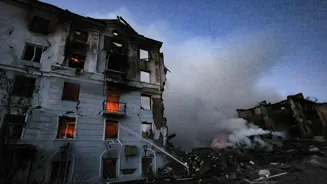A Ukrainian drone flew over 1,000 kilometres into Russian territory and hit an ammunition depot amid its ongoing conflict with Russia. The drone attack was a bold showcase of the evolution of Ukraine’s
defence industry during the war.
The strike meant a lot to Iryna Terekh, the woman in charge of building those drones at a private company called Fire Point. It came only a day after a Russian glide bomb had hit her hometown, Kharkiv. The successful counterstrike was more than military strategy for Tarekh.
“Fighting in the air is our only real asymmetric advantage on the battlefield at the moment. We don’t have as much manpower or money as they have,” Terekh, Fire Point’s head of production, was quoted as saying by the Associated Press.
Driven by its fight for survival against Russia and facing only limited support from Western allies, Ukraine has quickly turned into a major hub for defence innovation. The aim is to keep up with — or even surpass — Russia’s military technology. Fire Point is one of the leading companies making that happen.
Fire Point, And Its Journey To Become A Drone Powerhouse
A small group of friends with no background in weapons — just experience in architecture, gaming, and construction—started Fire Point. But after the 2022 invasion, they turned their skills into innovation, building drones capable of reaching deep into enemy territory.
Fire Point has grown rapidly since then, with the company making nearly 100 drones a day, up from just 30 a month last year. The cost of each drone is around USD 55,000, and it carries a 60 kg explosive payload. These long-range drones, called FP-1, are now behind 60 per cent of Ukraine’s deep strikes on Russian targets like oil depots and weapons factories.
The Associated Press was given exclusive access to one of Fire Point’s secret factories, where the focus was firmly on their groundbreaking FP-1 drone. This long-range explosive drone can travel up to 1,600 kilometers (994 miles), making it a powerful tool for striking deep inside enemy territory.
Designed for precision and efficiency, the FP-1 carries a substantial payload and operates without the need for traditional airfields, allowing it to be launched from virtually anywhere. Its success has made it a cornerstone of Ukraine’s defence strategy.
Besides the drone, Fire Point also unveiled a new cruise missile capable of flying 3,000 kilometres (1,864 miles), which Ukrainian President Volodymyr Zelenskyy hopes to mass-produce by the end of the year.
Why Ukraine Builds Its Own Weapons?
With limited access to long-range Western weapons, Ukraine had no choice but to develop its own. The government has invested about USD 10 billion annually in domestic arms production and relaxed rules to encourage private companies to build and test military tech quickly.
Many factories, like Fire Point’s, operate in secret locations — sometimes in civilian areas — to avoid Russian airstrikes. But that creates its own risks.
Preparing For The Future
Even as Ukraine’s leaders push for peace talks, defence officials remain cautious. “We believe our best guarantee is not relying on somebody’s will to protect us, but rather our ability to protect ourselves,” said Arsen Zhumadilov, head of Ukraine’s arms procurement agency.
Terekh also remains sceptical whether the peach talks will bring complete peace. “We are preparing for a bigger, much scarier war,” she said.
(With inputs from AP)















